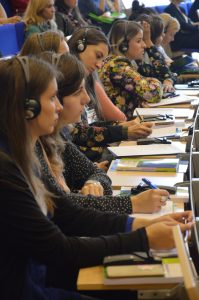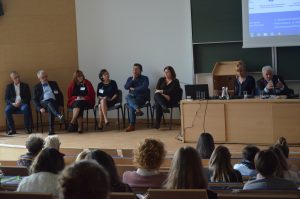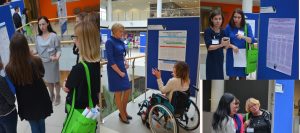The account of the 5th International Conference of Logpedics: Logopedics in Theory and Practice
The main point of interest of this year’s conference was the future and development of logopedics, and especially the issues concerning scientific basis for assessment and therapy of children and elderly, as well as clinical view on methods and diagnostic tools in logopedics.
The conference was opened by prof. Alicja Ratuszna, the originator of the Silesian Centre for Education and Interdisciplinary Research in Chorzów where the conference took place this year. The guests were also welcomed by representatives of the organizers of the conference: Dean for Promotion and Cooperation of the Faculty of Philology prof. Magdalena Pastuchowa, reverend dr Wacław Królikowski from the Non-Resident Faculty of Humanities and Social Sciences of Jesuit University Ignatianum in Mysłowice, and dr Joanna Trzaskalik from the Silesian Department of Polish Logopedic Society, who presented this year’s Logopedia Silesiaca award. The idea behind Logopedia Silesiaca is to show gratefulness to people or institutions responsible for contributing to Silesian logopedics. This year’s laureate was Marzena Lampart-Busse: the leader of the Team of SLTs’ Vocational Training in Rybnik, great specialist in speech therapy for the deaf and hard of hearing, and neurological speech and language therapy, author of many publications, including the book entitled: “Speech and language therapy stories. Using non-verbal stimuli in aural perception training.”
Logopedics, being a trans-disciplinary area, has drawn many great specialists to the conference. They discussed various theoretical and practical issues related to speech and language therapy. The first speech was presented by prof. dr. hab. Stanisław Grabias, who placed logopedics among other scientific areas related to it. Next, Henriette Langdon, PhD, a communication disorder specialist from the US took the floor. She delivered a speech on the implications of mono- and bilingualism for SLT assessment in children. The first session of keynote speeches ended with dr hab. prof. UMCS Tomasz Woźniak’s speech on evidence-based speech and language therapy.
The second panel was devoted to therapy techniques in case of particular disorders. Prof. dr Yulia O. Filatova from Russian Federation discussed rhytmic processes in speech development and disorders. Kurt Eggers, PhD from Belgium presented the newest tendencies in stuttering therapy which are evidence based, which alluded to the ideas presented by prof. Woźniak earlier that day. At the end of this session, dr hab. Irena Polewczyk delivered a speech on the educational challenges of school children with APD.
After both keynote sessions, the guests could exchange their opinions and experiences in the discussion panel “Where is logopedics heading to?”. The main points of the discussion revolved around the place of logopedics among other disciplines, the need of establishing a major in logopedics at a university which would result in the possibility to obtain a PhD in logopedics, as opposed to PhD in linguistics, educational sciences or medical sciences specializing in logopedics, as it is practiced at the moment. Also evidence based practice was discussed in greater detail.
The first day of the conference was concluded with 5 speech panel sections which deliberated on many aspects of speech therapy and its effectiveness.
The second day started with keynote speeches on articulation and articulation disorders presented by Polish researchers. Dr hab. prof. UŚ Barbara Ostapiuk discussed the reasons behind inconsistent assessment of lingual frenulum. Factors affecting pre-, peri-and early postnatal wellbeing in children with consonant devoicing were the topic of dr hab. Lilianna Konopska’s speech. At the end of the first part of keynote session for that day, dr hab. Anita Lorenc presented the results of her research into pronunciation of Polish retroflex sounds which she carried out in collaboration with Technology Institute of the Polish Academy of Sciences.
After a discussion panel and a coffee break, the keynote session was resumed. Prof. Eliana Danilavichiutie from Ukraine prof. Karel Neubauer from Czech Republic presented newest insights into neurological speech language therapy. At the end of the keynote session, in her speech “Speech therapy effectiveness in case of the disorder of primary activities and articulation disorders”, prof. UŚ Danuta Pluta-Wojciechowska showed research results based on the analysis of her own patients’ records from the past 5 years.
At the end of the second day of the conference the participants could take part in workshops carried out by leading specialists in speech language therapy. The workshops touched upon: children with APD, aphasia or primary functions disorders, voice therapy in vocal cord paralysis and spasmodic dysphonia, the role of dialogue in assessment and speech language therapy, and early reading.
The conference also involved a poster session which created yet another opportunity to present newest research results in the area of speech and language therapy. The posters presented modern therapy techniques and technology involved in therapy of children, as well as research into primary functions disorders and speech disorders. The authors of the posters came from Poland, Russian Federation, Ukraine, Great Britain, and the United States.
This year’s event was highly successful and widely discussed in the academic community in Poland and abroad. Around 200 people came to Chorzów to take part in the conference and all of them had the chance to listen to keynotes by specialists from all over the world and to actively participate in discussions thanks to simultaneous interpreting provided by the organizers.
Text: Anna Mitura, dr Joanna Przyklenk
Photos: Małgorzata Grzonka



